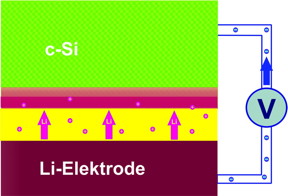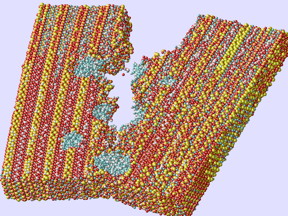Science
NASA Climate Modeling Suggests Venus May Have Been Habitable

Observations suggest Venus may have had water oceans in its distant past. A land-ocean pattern like that above was used in a climate model to show how storm clouds could have shielded ancient Venus from strong sunlight and made the planet habitable.
- Read more
- 394 reads
Let's roll: Material for polymer solar cells may lend itself to large-area processing: 'Sweet spot' for mass-producing polymer solar cells may be far larger than dictated by the conventional wisdom

A demonstration solar park based on polymer solar cells at the Technical University of Denmark in Roskilde, Denmark.
- Read more
- 408 reads
Seeing the invisible: Visible light superlens made from nanobeads: New solid 3-D superlenses extends magnification x5 to reveal new detail

Fig.1 (a) Conceptual drawing of nanoparticle-based metamaterial solid immersion lens (mSIL) (b) Lab made mSIL using titanium dioxide nanoparticles (c) SEM image of 60 nm sized imaging sample (d) corresponding superlens imaging of the 60 nm samples by the developed mSIL.
- Read more
- 370 reads
Seeing the invisible: Visible light superlens made from nanobeads: New solid 3-D superlenses extends magnification x5 to reveal new detail
A paper in Science Advances (12 August) provides proof of a new concept, using new solid 3D superlenses to break through the scale of things previously visible through a microscope.
- Read more
- 336 reads
Kepler Watches Stellar Dancers in the Pleiades Cluster.
Like cosmic ballet dancers, the stars of the Pleiades cluster are spinning. But these celestial dancers are all twirling at different speeds. Astronomers have long wondered what determines the rotation rates of these stars.
- Read more
- 414 reads
NREL technique leads to improved perovskite solar cells
The research, funded by the U.S. Department of Energy SunShot Initiative, involved hybrid halide perovskite solar cells and revealed treating them with a specific solution of methyl ammonium bromide (MABr) would repair defects, improving efficiency. The scientists converted a low-quality perovskite film with pinholes and small grains into a high-quality film without pinholes and with large grains. Doing so boosted the efficiency of the perovskite film in converting sunlight to 19 percent.
- Read more
- 363 reads
Cement design should take into account the water confined in the smallest pores: A researcher at the UPV/EHU-University of the Basque Country is participating in the study of the stresses of confined water in the micropores of cement at extreme temperatur
These variations in humidity and temperature are translated into physical processes involving evaporation or freezing of the water contained in the cement paste, which often cause stresses and even micro-cracking inside the cement. Characterizing the response to these phenomena affecting the confined water in the smallest pores of the cement "is hugely important as a large proportion of the water, about 30 %, is located in these small spaces, so to a great extent it contributes towards the final properties of the material," explained Hegoi Manzano, a researcher in the UPV/EHU's department of Condensed Matter Physics, and author of the study in collaboration with a research group of the University of Tohoku in Japan.
- Read more
- 352 reads
Prototype chip could help make quantum computing practical: Built-in optics could enable chips that use trapped ions as quantum bits

Researchers from MIT and MIT Lincoln Laboratory report an important step toward practical quantum computers, with a paper describing a prototype chip that can trap ions in an electric field and, with built-in optics, direct laser light toward each of them.
- Read more
- 412 reads
Lithium-ion batteries: Capacity might be increased by 6 times

Lithium ions migrate through the electrolyte (yellow) into the layer of crystalline silicon (c-Si). During the charging cycle, a 20-nm layer (red) develops on the silicon electrode adsorbing extreme quantities of lithium atoms.
- Read more
- 357 reads
Nothing -- and something -- give concrete strength, toughness: Rice University scientists show how voids, particles sap energy from cracks

Rice University researchers used computer models of concrete's inner matrix to show how tiny holes filled with portlandite (blue) impart strength and toughness by preventing the spread of cracks.
- Read more
- 416 reads
Human Rights
Fostering a More Humane World: The 28th Eurasian Economic Summi

Conscience, Hope, and Action: Keys to Global Peace and Sustainability

Ringing FOWPAL’s Peace Bell for the World:Nobel Peace Prize Laureates’ Visions and Actions

Protecting the World’s Cultural Diversity for a Sustainable Future

Puppet Show I International Friendship Day 2020

